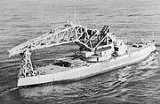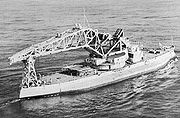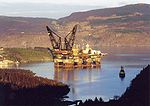
Crane vessel
Encyclopedia

Ship
Since the end of the age of sail a ship has been any large buoyant marine vessel. Ships are generally distinguished from boats based on size and cargo or passenger capacity. Ships are used on lakes, seas, and rivers for a variety of activities, such as the transport of people or goods, fishing,...
with a crane
Crane (machine)
A crane is a type of machine, generally equipped with a hoist, wire ropes or chains, and sheaves, that can be used both to lift and lower materials and to move them horizontally. It uses one or more simple machines to create mechanical advantage and thus move loads beyond the normal capability of...
specialized in lifting heavy loads. The largest crane vessels are used for offshore construction
Offshore construction
Offshore construction is the installation of structures and facilities in a marine environment, usually for the production and transmission of electricity, oil, gas and other resources....
. Conventional monohull
Monohull
rightA monohull is a type of boat having only one hull, unlike multihulled boats which can have two or more individual hulls connected to one another.-Fundamental concept:...
s are used, but the largest crane vessels are often catamaran
Catamaran
A catamaran is a type of multihulled boat or ship consisting of two hulls, or vakas, joined by some structure, the most basic being a frame, formed of akas...
or semi-submersible
Semi-submersible
A semi-submersible is a specialised marine vessel with good stability and seakeeping characteristics. The semi-submersible vessel design is commonly used in a number of specific offshore roles such as for offshore drilling rigs, safety vessels, oil production platforms and heavy lift cranes.The...
types as they have increased stability. On a sheerleg
Sheerleg
A sheerleg is a floating crane, but compared to crane vessel it is not capable of rotating the crane separate from the ship.There is a huge variety in sheerlegs when it comes to size and capacity. The smaller cranes start around 50 tons in lifting capacity, with the largest being able to lift over...
crane, the crane is fixed and cannot rotate, and the vessel therefore is manoeuvered to place loads.
History
In medieval Europe, crane vessels which could be flexibly deployed in the whole port basin were introduced as early as the 14th century.During the age of sail
Age of Sail
The Age of Sail was the period in which international trade and naval warfare were dominated by sailing ships, lasting from the 16th to the mid 19th century...
, the sheer hulk was used extensively as a floating crane for tasks that required heavy lift. At the time, the heaviest single components of ships were the main masts, and sheer hulks were essential for removing and replacing them, but they were also used for other purposes.
In 1920, the 1898-built battleship
Battleship
A battleship is a large armored warship with a main battery consisting of heavy caliber guns. Battleships were larger, better armed and armored than cruisers and destroyers. As the largest armed ships in a fleet, battleships were used to attain command of the sea and represented the apex of a...
was converted to a crane ship when a crane
Crane (machine)
A crane is a type of machine, generally equipped with a hoist, wire ropes or chains, and sheaves, that can be used both to lift and lower materials and to move them horizontally. It uses one or more simple machines to create mechanical advantage and thus move loads beyond the normal capability of...
with a capacity of 250 tons was installed. Later it was renamed Crane Ship No. 1. It was used, amongst other things, to place guns and other heavy items on battle ships under construction. Another remarkable feat was the raising of the in 1939.
In 1942 the Crane Ships aka "Heavy Lift Ships" SS Empire Elgar (PQ16), SS Empire Bard (PQ15), and SS Empire Purcell (PQ16) were sent to the Russian Arctic ports of Archangel, Murmansk and Molotovsk (Since renamed Sererodvinsk). Their role was to enable the unloading of the Arctic Convoys where port installations were either destroyed by German bombers or were non existent (as at Bakaritsa quay Archangel)
In 1949 J. Ray McDermott
J. Ray McDermott
McDermott International is an international engineering company specialized on marine solutions with operations in the Americas, Middle East, the Caspian Sea, and the Pacific Rim...
had the Derrick Barge Four built, a barge that was outfitted with a 150 tons revolving crane. The arrival of this type of vessel changed the direction of the offshore construction
Offshore construction
Offshore construction is the installation of structures and facilities in a marine environment, usually for the production and transmission of electricity, oil, gas and other resources....
industry. Instead of constructing oil platform
Oil platform
An oil platform, also referred to as an offshore platform or, somewhat incorrectly, oil rig, is a lаrge structure with facilities to drill wells, to extract and process oil and natural gas, and to temporarily store product until it can be brought to shore for refining and marketing...
s in parts, jackets and decks could be built onshore as modules. For use in the shallow part of the Gulf of Mexico
Gulf of Mexico
The Gulf of Mexico is a partially landlocked ocean basin largely surrounded by the North American continent and the island of Cuba. It is bounded on the northeast, north and northwest by the Gulf Coast of the United States, on the southwest and south by Mexico, and on the southeast by Cuba. In...
, the cradle of the offshore industry, these barges sufficed.
In 1963 Heerema converted a Norwegian
Norway
Norway , officially the Kingdom of Norway, is a Nordic unitary constitutional monarchy whose territory comprises the western portion of the Scandinavian Peninsula, Jan Mayen, and the Arctic archipelago of Svalbard and Bouvet Island. Norway has a total area of and a population of about 4.9 million...
tanker, the Sunnaas, into a crane vessel with a capacity of 300 tons, the first one in the offshore industry that was ship-shaped. It was renamed Global Adventurer. This type of crane vessel was better adapted to the harsh environment of the North Sea
North Sea
In the southwest, beyond the Straits of Dover, the North Sea becomes the English Channel connecting to the Atlantic Ocean. In the east, it connects to the Baltic Sea via the Skagerrak and Kattegat, narrow straits that separate Denmark from Norway and Sweden respectively...
.

Hermod (ship)
SSCV Hermod is a semi-submersible crane vessel operated by Heerema Marine Contractors.-History:Semi submersible crane vessel Hermod was constructed in 1979 by Mitsui Engineering & Shipbuilding Co., Ltd.. Hermod and sister vessel, Balder were the world's first semi-submersible crane vessels...
and the Balder
DCV Balder
DCV Balder is a Deepwater Construction Vessel operated by Heerema Marine Contractors.-History:The Balder was constructed in 1978 as semi-submersible crane vessel by Mitsui Engineering & Shipbuilding Co., Ltd.. Balder and sister vessel, Hermod were the world's first semi-submersible crane vessels...
, each with one 2000 ton
Short ton
The short ton is a unit of mass equal to . In the United States it is often called simply ton without distinguishing it from the metric ton or the long ton ; rather, the other two are specifically noted. There are, however, some U.S...
and one 3000 ton crane. Later both were upgraded to a higher capacity. This type of crane vessel was much less sensitive to sea swell, so that it was possible to operate on the North Sea during the winter months. The high stability also allowed for heavier lifts than was possible with a monohull. The larger capacity of the cranes reduced the installation time of a platform
Oil platform
An oil platform, also referred to as an offshore platform or, somewhat incorrectly, oil rig, is a lаrge structure with facilities to drill wells, to extract and process oil and natural gas, and to temporarily store product until it can be brought to shore for refining and marketing...
from a whole season to a few weeks. Inspired by this success similar vessels were built. In 1985 the DB-102 was launched for McDermott, with two cranes with a capacity of 6000 tons each. Micoperi had the M7000 built in 1986 with two cranes of 7000 tons each.
However, in the mid 1980s the boom in the offshore industry was over, resulting in collaborations. In 1988 a joint venture
Joint venture
A joint venture is a business agreement in which parties agree to develop, for a finite time, a new entity and new assets by contributing equity. They exercise control over the enterprise and consequently share revenues, expenses and assets...
between Heerema and McDermott was formed, HeereMac. In 1990 Micoperi had to apply for bankruptcy. This enabled Saipem
Saipem
Saipem S.p.A. is an Italian oil and gas industry contractor. It is a subsidiary of Italian energy company Eni, which owns approximately 43% of Saipem's shares. Saipem has contracted for designing and constructing several pipelines, including Blue Stream, Greenstream, Nord Stream and South...
– in the beginning of the 1970s a large heavy lift contractor, but only a small player in this field at the end of the 80s – to take over the M7000 in 1995, later renaming it Saipem 7000. In 1997 Heerema took over the DB-102 from McDermott after discontinuation of their joint venture. The ship was renamed Thialf
SSCV Thialf
SSCV Thialf is a semi-submersible crane vessel operated by Heerema Marine Contractors, the largest crane vessel in the world.-History:SSCV Thialf was constructed in 1985 as DB-102 for McDermott by Mitsui Engineering & Shipbuilding Co., Ltd...
and, after an upgrade in 2000 to twice 7100 tons, it is now the largest crane vessel in the world even if all the world's lifting records belong to the Saipem 7000 (12150t of Sabratha Deck).
Heavy Lift vessels
| Vessel | Company | Capacity (mT Tonne The tonne, known as the metric ton in the US , often put pleonastically as "metric tonne" to avoid confusion with ton, is a metric system unit of mass equal to 1000 kilograms. The tonne is not an International System of Units unit, but is accepted for use with the SI... ) |
Type |
|---|---|---|---|
| Heerema Marine Contractors Heerema Marine Contractors Heerema Marine Contractors is a contractor most notable for operation of three of the largest crane vessels in the offshore industry.-History:... |
14,200 (tandem) | Semi-submersible | |
| Saipem 7000 Saipem 7000 Saipem 7000 is the world's second largest crane vessel, after the Thialf. The crane radius of the Saipem 7000 grants a lifting capability of 14,000 tonnes at 42 meters while the Thialf can lift 14,200 tonnes at 31.2 meters... |
Saipem Saipem Saipem S.p.A. is an Italian oil and gas industry contractor. It is a subsidiary of Italian energy company Eni, which owns approximately 43% of Saipem's shares. Saipem has contracted for designing and constructing several pipelines, including Blue Stream, Greenstream, Nord Stream and South... |
14,000 (tandem) | Semi-submersible |
| Svanen | Ballast Nedam | 8,700 | Catamaran |
| Hermod Hermod (ship) SSCV Hermod is a semi-submersible crane vessel operated by Heerema Marine Contractors.-History:Semi submersible crane vessel Hermod was constructed in 1979 by Mitsui Engineering & Shipbuilding Co., Ltd.. Hermod and sister vessel, Balder were the world's first semi-submersible crane vessels... |
Heerema Marine Contractors Heerema Marine Contractors Heerema Marine Contractors is a contractor most notable for operation of three of the largest crane vessels in the offshore industry.-History:... |
8,100 (tandem) | Semi-submersible |
| Lan Jing | CNOOC | 7,500 | Monohull |
| Balder DCV Balder DCV Balder is a Deepwater Construction Vessel operated by Heerema Marine Contractors.-History:The Balder was constructed in 1978 as semi-submersible crane vessel by Mitsui Engineering & Shipbuilding Co., Ltd.. Balder and sister vessel, Hermod were the world's first semi-submersible crane vessels... |
Heerema Marine Contractors Heerema Marine Contractors Heerema Marine Contractors is a contractor most notable for operation of three of the largest crane vessels in the offshore industry.-History:... |
6,945 (tandem) | Semi-submersible |
| Seven Borealis | Subsea 7 Subsea 7 Subsea 7 S.A. is a subsea engineering and construction company. Registered in Luxembourg and with its headquarters in London in the United Kingdom, the firm assumed its current form in January 2011 when Acergy S.A... |
5,000 | Monohull |
| Oleg Strashnov | Seaway Heavy Lifting | 5,000 | Monohull |
| PJW 4000 | Swiber Offshore | 4,200 | Monohull |
| Aegir | Heerema Marine Contractors Heerema Marine Contractors Heerema Marine Contractors is a contractor most notable for operation of three of the largest crane vessels in the offshore industry.-History:... |
4,000 | Monohull |
| DB 50 | J. Ray McDermott J. Ray McDermott McDermott International is an international engineering company specialized on marine solutions with operations in the Americas, Middle East, the Caspian Sea, and the Pacific Rim... |
4,400 | Monohull |
| Rambiz | Scaldis | 3,300 | Catamaran |
| Asian Hercules II | Smit International Smit International Smit Internationale N.V. is a Dutch company operating in the maritime sector. The company was founded in 1842 by Fop Smit as a towage company with only the 140 hp paddle steamer tug 'Kinderdijk'.... |
3,200 | Monohull |
| DB 101 | J. Ray McDermott J. Ray McDermott McDermott International is an international engineering company specialized on marine solutions with operations in the Americas, Middle East, the Caspian Sea, and the Pacific Rim... |
3,500 | Semi-submersible |
| DB 30 | J. Ray McDermott J. Ray McDermott McDermott International is an international engineering company specialized on marine solutions with operations in the Americas, Middle East, the Caspian Sea, and the Pacific Rim... |
3,080 | Monohull |
| LTS 3000 | L&T-SapuraCrest JV | 2,722 | Monohull |
| Sapura 3000 | SapuraAcergy Acergy Acergy S.A. was an international offshore seabed to surface engineering and construction company previously known as Stolt Offshore and Stolt Comex Seaway and was part of the Stolt-Nielsen Group until 2005... |
3,000 | Monohull |
| Stanislav Yudin | Seaway Heavy Lifting | 2,500 | Monohull |
| Saipem 3000 | Saipem Saipem Saipem S.p.A. is an Italian oil and gas industry contractor. It is a subsidiary of Italian energy company Eni, which owns approximately 43% of Saipem's shares. Saipem has contracted for designing and constructing several pipelines, including Blue Stream, Greenstream, Nord Stream and South... |
2,177 | Monohull |
| Huasteco | Grupo Protexa | 2,000 | Monohull |
| Tolteca | CAMSA | 2,000 | Monohull |
| Quippo Prakash | MDL/Quippo/Sapura JV | 2,000 | Monohull |
External links
- L&T-SapuraCrest JV
- Heerema Marine Contractors
- J. Ray McDermott Marine Installation
- Micoperi Marine Contractors
- Saipem Offshore Construction
- A page about an old german floating crane from 1915
- Seaway Heavy Lifting
- A Gigantic Muscle of Steel: it picks up a sunken tugboat from the harbor bottom as easily as you'd lift ten pounds off the floor, Popular SciencePopular SciencePopular Science is an American monthly magazine founded in 1872 carrying articles for the general reader on science and technology subjects. Popular Science has won over 58 awards, including the ASME awards for its journalistic excellence in both 2003 and 2004...
monthly, February 1919, page 67, Scanned by Google Books - D&L Salvage Marine Construction

